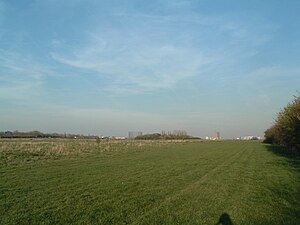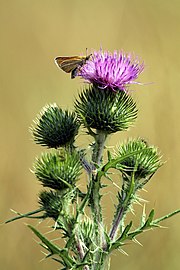Wormwood Scrubs

Wormwood Scrubs, known locally as The Scrubs (or simply Scrubs), is an open space in Middlesex located deep within the conurbation spreading out from London. It is the largest areas of common land in this inner part of the county, at 200 acres. The eastern part, known as Little Wormwood Scrubs, is cut off by Scrubs Lane and the West London Line railway.
This has been an open public space since the Wormwood Scrubs Act of 1879.
The southern edge of the Scrubs is the site of two locally important buildings. At the western end is HM Prison Wormwood Scrubs, built between 1875 and 1891 by convict labour. To the east of the prison is the Hammersmith Hospital campus, which includes the relocated Queen Charlotte's and Chelsea Hospital.
Within the area are several sports facilities, including the Linford Christie stadium, tens of football pitches and a pony centre[1]. Queens Park Rangers Football Club played on Wormwood Scrubs between 1893 and 1896.
History
In the early 19th century the whole district was open fields, and included several areas of common land. In 1812 an area of 190 acres known as 'Wormholt Scrubs' was leased by the War Office from the Manor of Fulham. This was in order to exercise cavalry horses which until that point had been hacked out in Hyde Park, Belgrave Square and Regent's Park - then known as St Marylebone's Park. This common land became known as Wormwood Scrubs, 135 acres of which was bought by the War Office in 1878.
In 1879, Parliament passed the Wormwood Scrubs Act, which aimed to create a "metropolitan exercising ground" for the military and to provide the Scrubs for "the perpetual use by the inhabitants of the metropolis for exercise and recreation". Under this act, the military were able to expel civilians from the area whenever they were training, but allowed civilians free use of it when they were not. To ensure that it was kept as open land for all to enjoy, the act banned the military from building any permanent structures other than rifle butts, one of which survives today as a wall in the Linford Christie Stadium.
Wormwood Scrubs became recognised as the duelling ground of London, with several duels fought there.[2]
In 1908, the route for the Olympic Marathon went across the Scrubs on the final stages of the race from Windsor Castle to the Olympic Stadium at White City. In 1910 Wormwood Scrubs became part of aviation history when a pioneer airship took flight from an improvised landing ground; The Daily Mail Airship Garage was built shortly afterwards—the site is now occupied by the stadium. In 1914 all air related activities on the Scrubs passed to the authority of the Admiralty, and there are records of a base here called 'Wormwood Scrubs Naval Air Station' in the National Archives at Kew. The airship shed was used to train RNAS armoured car crews.[3] It remained as an emergency landing ground until the 1930s. In 1939 with the onset of the Second World War, Wormwood Scrubs again played host to an innovative military department—The Chief Cable Censorship Department, an outstation of the Government Code and Cypher School at Bletchley Park.
Until 1940 the area was served by St Quintin Park and Wormwood Scrubs, a station on the West London Line. It was closed after heavy bombing damage during the Second World War.
The prison is located just yards from the scene of the Massacre of Braybrook Street in 1966, in which three policemen were shot dead by three armed men after stopping their suspicious car.
In 1986 local birdwatcher Lester Holloway set up a campaign to save Scrubs Wood,[4] the area of railway land along the north side of Wormwood Scrubs, from destruction as part of plans by the then British Rail to build cleaning depots (see North Pole depot) to service Channel Tunnel trains. Holloway and his campaign petitioned the House of Lords,[5] supported by the then local MP, and won concessions. The existing nature reserve includes an area known as 'Lester's Embankment'.[6] The campaign attracted considerable national publicity in 1987, and even a musical.[7]
On 10 March 2009 the prison was listed as a Grade II building.[8]
As one of the largest open spaces close to central London, Wormwood Scrubs is always under threat of development. The local politics are a constant battle between vigilant groups like The Friends of Wormwood Scrubs[9] and various interests who might have an eye to building on the green space.
Finances
The Wormwood Scrubs Charitable Trust, a charity set up under the Act of Parliament to manage this public space "for the exercise and recreation of the inhabitants of the metropolis", receives a substantial income stream from the lease to Hammersmith Hospital of a car park on its Southern boundary. Other sources of income from the space include the rental of sports fields, advertising billboards, and two public car parks. The accounting for costs and revenues of the Charity have been a matter of debate between the Council, currently sole Trustee of the Trust, and the Friends of Wormwood Scrubs.
Local Nature Reserve

Areas of Wormwood Scrubs are a Local Nature Reserve. These areas include Braybrook Woods, Martin Bell's Wood and the Central Woodland Copse. Habitats include woodland (plantation), scrub and grassland. Animals include common lizards, over 100 species of bird and 20 species of butterfly.[10]
Current conservation efforts
Conservation work currently being carried out in Wormwood Scrubs by Groundwork London has been the subject of controversy among users of the Scrubs. The primary goal is to connect each patch of the Local Nature Reserve within the grounds by a wildlife corridor in the form of low hedges and trees. Ultimately, it is claimed that this will benefit biodiversity in the park and create better foraging routes for bats such as the common pipistrelle. Habitats for the local common lizards are also being improved, for example by the removal of scrub to create basking areas. This work includes planting a large number of trees, and it is feared that this could jeopardise the open nature of the common. The bulk of the work is currently being undertaken by volunteers for Groundwork London, a government quasi non-governmental organisation funded largely through a levy on landfill.
Outside links
| ("Wikimedia Commons" has material about Wormwood Scrubs) |
- Location map: 51°31’17"N, 0°14’20"W
- Notes on Wormwood Scrubs
- Hammersmith and Fulham Volunteer Centre
- oldoakcentre.co.uk
References
- ↑ Wormwood Scrubs Pony Centre
- ↑ "The Portland Peerage Romance (1907)". Nottshistory.org.uk. 2004-04-16. http://www.nottshistory.org.uk/portland1907/portland6.htm. Retrieved 2010-11-02.
- ↑ The Devil's Chariots, John Glanfield, Sutton Publishing Ltd 2001, ISBN 0-7509-4152-9 (p.58)
- ↑ http://scrubs.ground-level.org/stories/storyReader$158
- ↑ "Channel Tunnel Bill (Hansard, 6 July 1987)". Hansard.millbanksystems.com. http://hansard.millbanksystems.com/lords/1987/jul/06/channel-tunnel-bill-1. Retrieved 2010-11-02.
- ↑ "October 2008 Sightings at Wormwood Scrubs" (PDF). http://www.scrubs-online.org.uk/Documents/Bird%20Reports/2008/BirdsOctober2008.pdf. Retrieved 2010-11-02.
- ↑ "The Wild Side Of Town". Ashleyhutchings2.tripod.com. http://ashleyhutchings2.tripod.com/thewildsideoftown.html. Retrieved 2010-11-02.
- ↑ ''Ere Fletch they've only gone and listed the Scrubs': Mira Bar-hillel in The Daily Mail.
- ↑ "The Friends of Wormwood Scrubs". http://friendsofwormwoodscrubs.org.uk/?page_id=7.
- ↑ Wormwood Scrubs Local Nature Reserves (Natural England)
